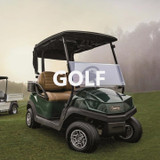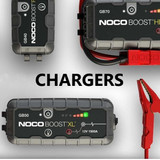Battery 101: The Difference Between a Trickle Charger and a Regular Battery Charger
A lot of factors that come into play when trying to decide the right battery. More importantly, once you’ve chosen the right battery for your application you need to know the correct way to it.
Does the battery need to be charged quickly? Is the battery going to be stored for a while? Does it just need to be kept charged until its next use? Questions like these help to determine if you need a regular battery or a trickle charger. Here we’ve broken down the difference between the two.
Regular Battery Charger
A regular battery charger is designed to charge a battery as quickly and as safely as possible.
Did you know? Charging a battery too fast can damage the battery, reducing its performance capacity, shortening its life cycle and even cause it to catch fire. For these reasons, it’s important to not rush the process. A standard battery chargers purpose is to send a constant voltage to the battery until it’s turned off.
This means that you have to check the battery and make sure to not let the charger stay connected past the point of a full charge. That will help you avoid mistakes many batteries owners make.
Is it right for you? This type of charger is ideal if you are trying to charge up your battery for immediate use.
Trickle Charger
A trickle charger is a battery charger that delivers a very low voltage. This means that the battery will be charged slowly over a period of time.
Did you know? When preparing to store a battery for a period of time, it’s best to make sure that the battery is charged fully at the time of storage and that it receives periodic charging during its time in storage. That way when you’re ready to use it for your application, you’re ready to go.
A trickle charger removes the need to recharge periodically, as it feeds a constant low charge to the battery without the pronounced risk of overcharging. It’s important to note that a trickle charger and a maintenance charger are not the same things.
A trickle charger will deliver a charge that is equal to the batteries rate of self-discharge and should be disconnected once a full charge has been established to avoid overcharging. A maintenance charger is designed to stay connected to the battery. Once a charge level is set, the charger will automatically turn off and on to maintain the specified charge range.
Regular Chargers vs. Trickle Chargers
A trickle chargers’ primary purpose is to slowly charge a battery and prevent overcharging – however, the same result can be achieved through the use of a standard charger.
If storing batteries for a period of time is a common activity, then it’s safe to say a trickle charger may be a good investment. On the other hand, if your primary battery charging activities require a quick charge for immediate use with the occasional need to store a battery, you’d be better off investing in a regular charger, and just plan on charging the stored battery every 30 to 45 days.
Just make sure that the battery is fully charged before you put it away and you should be able to maintain its charge without a problem.
Fast vs. Slow
Charging a battery as fast as you can is not always the best solution – here’s why:
When a battery is being charged, the process of discharge is being reversed. This means that the chemical process that allowed the battery to provide power has to go back to its original state.
The heat from the charging process allows this chemical reversal to happen – however, too much heat, or amperage can create an adverse effect called off-gassing. The gas being released is extremely flammable and unsafe to breathe. When charging any battery, you should be in a well-ventilated area and pay close attention to avoid overcharging.
POPULAR ARTICLES
-
Get Ready for Spring: Golf-Cart Battery Care and Charging Tips
Jan 23, 2024Everyone’s guilty of some mistakes with their batteries. The results of these well-intentioned actio
-
Pocket Power: Best Features of Lithium-Ion Battery Boosters
Jan 23, 2024Every device today seems to have a battery. That statement isn’t an exaggeration either. In fact, it
-
Where You Can Drive Golf Carts
Jan 23, 2024It’s the peak of summer vacation time and everyone is wanting to take a golf cart and hit the roads



